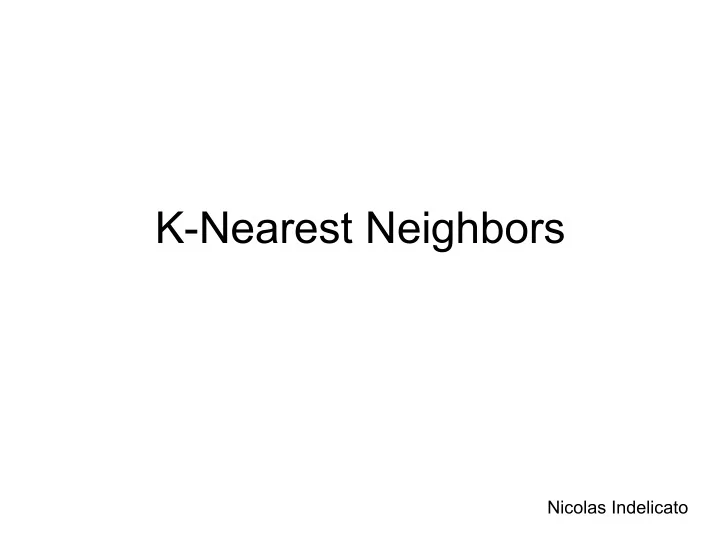

K-Nearest Neighbors Nicolas Indelicato
K-Nearest Neighbors • Dataset Background • How the Algorithm Works • Optimizing the Algorithm • Results • Issues • Summary
Dataset Background • Wine Dataset – 13 Attributes • Alcohol, Malic Acid, Ash, Alcalinity of Ash, Magnesium, Total Phenols, Flavanoids, NonFlavanoid Phenols, Proanthocyanins, Color Intensity, Hue, OD280/D315 of Diluted Wines, Proline – Wide Range of Correlations • 2% in Ash to 83% in Flavanoids
Dataset Background Wine (continued) – 3 Classes • Class 1, Class 2, Class 3 wine – Attribute Weights • Nonflavanoid Phenols from 0.13 to 0.66 • Proline from 290 to 1680
Dataset Background • Iris Dataset – 4 Attributes • Sepal Length, Sepal Width, Petal Length, Petal Width – Range of Correlations • Sepal Width of 42% to Petal Lenth of 95% and Petal Width of 96% – 3 Classes • Iris-Setosa, Versicolor, and Virginica – Attribute Weights • Petal Width from 0.1 to 2.5 • Sepal Lentrh from 4.3 to 7.9
Dataset Background • Datasets include entities with similar attributes. • Determining the class cannot be done easily or quickly. • Descriptive Statistics is inefficient and cumbersome.
How the Algorithm Works • Instance-based • Used in classification and pattern recognition since the 1960s. • Minor training phase. • Customizable – Distance Method – k
How the Algorithm Works • K – Fixed constant – Determines number of elements to be included in each neighborhood. • Neighborhood determines classification • Different k values can and will produce different classifications
How the Algorithm Works • 1 Nearest Neighbor – Point x q classified as a “ + ” • 5 Nearest Neighbors – Point x q classified as a “ - ”
How the Algorithm Works • Euclidean Distance in n space. • a r (x) = r th attribute of instance x • x I and x J represent two separate instances • Distance = Square Root of the Sum of the Squares.
Optimizing the Algorithm • Correlation – Does low correlation mean irrelevant attributes? • Missing values – Will missing values make the results erroneous? • Normalization – Will normalization of the attributes make the results more accurate? • Size – How efficiently does the algorithm classify data?
Results • Iris Dataset – Non-normalized • All attributes – Misclassification rate = 6% – 94% Accuracy » Setosa misclassified = 0/150 = 0% » Versicolor misclassified = 0/150 = 0% » Virginica misclassified = 9/150 = 6%
Results • Iris Dataset – Normalized • All attributes – Misclassification rate = 7.33% – 92.67% Accuracy » Setosa misclassified = 0/150 = 0% » Versicolor misclassified = 1/150 = 0.67% » Virginica misclassified = 10/150 = 6.67%
Results • Iris Dataset – Non-normalized • Petal Length and Petal Width – Misclassification rate = 4.67% – 95.33% Accuracy » Setosa misclassified = 0/150 = 0% » Versicolor misclassified = 0/150 = 0% » Virginica misclassified = 7/150 = 4.67%
Results • Iris Dataset – Normalized • Petal Length and Petal Width – Misclassification rate = 7.33% – 92.67% Accuracy » Setosa misclassified = 0/150 = 0% » Versicolor misclassified = 0/150 = 0% » Virginica misclassified = 11/150 = 7.33%
Results • Wine Dataset – Non-normalized • All attributes – Misclassification rate = 27.45% – 72.55% Accuracy » Class 1 wine misclassified = 7/153 = 4.58% » Class 2 wine misclassified = 23/153 = 15.08% » Class 3 wine misclassified = 12/153 = 7.84%
Results • Wine Dataset – Normalized • All attributes – Misclassification rate = 5.88% – 94.12% Accuracy » Class 1 wine misclassified = 0/153 = 0% » Class 2 wine misclassified = 9/153 = 5.88% » Class 3 wine misclassified = 0/153 = 0%
Results • Wine Dataset – Non-normalized • Phenols, Flavanoids, OD280/OD315 – Misclassification rate = 20.92% – 79.08% Accuracy » Class 1 wine misclassified = 1/153 = 0.65% » Class 2 wine misclassified = 31/153 = 20.26% » Class 3 wine misclassified = 0/153 = 0%
Results • Wine Dataset – Normalized • Phenols, Flavanoids, OD280/OD315 – Misclassification rate = 20.92% – 79.08% Accuracy » Class 1 wine misclassified = 2/153 = 1.31% » Class 2 wine misclassified = 30/153 = 19.61% » Class 3 wine misclassified = 0/153 = 0%
Issues • Nearest neighbors include equal amount of neighbors from two classes. – Classified into class with nearest neighbor.
Summary • Dataset Background • How the Algorithm Works • Optimizing the Algorithm • Results • Issues
Recommend
More recommend